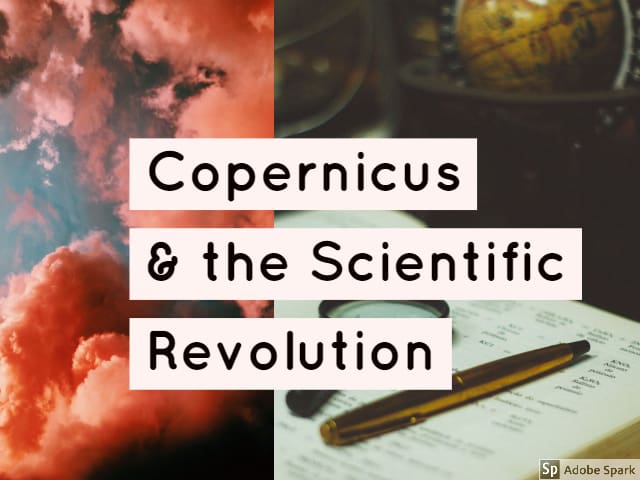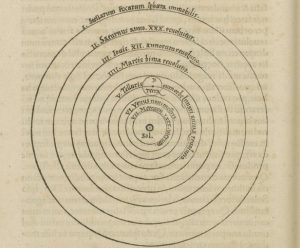Skill: CONTEXTUALIZATION
7th grade Social Studies
Students will already have background knowledge of the middle ages and the influential role the church had in Europe, from previous lessons.
The following pictures and mini-lesson will introduce us to the Scientific Revolution. The Scientific Revolution refers to the time frame between around 1550-1700 in Europe, where historical advances were made in science, mathematics, physics, anatomy, astronomy, etc.
The first picture comes from a book written in 1543 by Polish astronomer Nicolaus Copernicus, called “On the Revolution of the Celestial Spheres”. Copernicus is typically thought to be the man whose ideas sparked the Scientific Revolution.
Title: On the Revolution of the Celestial Spheres
Author: Nicolaus Copernicus
Year: 1543
Link to source
Title: Universe on the Model of Copernicus with Sun in Center
Artist: Andreas Cellarius
Year: 1660
Link to image source
Both pictures display Copernicus’ heliocentric model of the universe. Students will observe and notice the sun is in the center of these maps.
Questions for students to answer:
- How did people think the universe worked before Copernicus’ book was published?
- What do you think inspired Copernicus’ ideas?
- How do you think the church responded to Copernicus’ ideas and these pictures? Why?
- How do you think the general public responded?
Further guiding questions include:
- Copernicus chose not to publish this book (and release his drawings) until right before he died, 30 years later. Why do you think he did this?
- How do you think this is going to impact future ideas, and contribute to the Scientific Revolution?
Reflection:
Before doing this assignment, I had not given much thought to these historical thinking skills. Of course, I was aware of them, but I had never thought about how I would implement these skills in my class, or even the importance of these skills. With contextualization, I believe it gives students a chance to get the “big picture”. It forces students to think not just about the document in front of them, but also what is going on in the world during this time, in turn creating a more colorful story.
Looking at Copernicus’ pictures, students realize their significance when they put it in the context of 16th century Europe, where the ideas of the church rule the land and we are thought to be the center of the universe, and how revolutionary Copernicus’ ideas were.
When students are pushed to think deeper into history, not only will they learn more, but I believe they will also enjoy the process of learning.




Nicole,
Great post! Rather than just seeing these two documents as individual pieces of history, your questions to help students contextualize the documents really highlights the history and meaning of the documents. Instead of just seeing the documents as two old images, this lesson will help students better understand many aspects of the given time period. I agree – this will make the process of learning more enjoyable for all students involved.
Great post, Nicole! You made this mini lesson easy to follow along with great visuals. I enjoyed your reflection and how you go into depth on why students need to contextualize. As a whole, you can tell you put so much work into this. I would definitely do this lesson with my students!